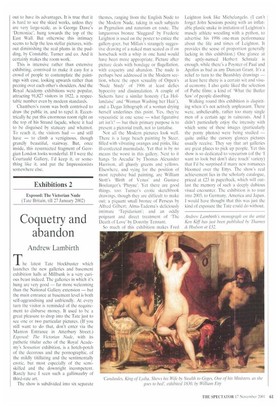Exhibitions 2
Exposed: The Victorian Nude (Tate Britain, till 27 January 2002)
Coquetry and abandon
Andrew Lambirth
The latest Tate blockbuster which launches the new galleries and basement exhibition halls at Millbank is a very curious beast indeed. The galleries in which it's hung are very good — far more welcoming than the National Gallery extension — but the main entrance at basement level is both self-aggrandising and unfriendly. At every turn the visitor is reminded of the requirement to disburse money. It used to be a great pleasure to drop into the Tate just to see one or two particular pictures. (If you still want to do that, don't enter via the Manton Entrance in Atterbury Street.) Exposed: The Victorian Nude, with its pathetic titular echo of the Royal Academy's Sensation exhibition, is a hotch-potch of the decorous and the pornographic, of the mildly titillating and the sentimentally erotic, but most especially of the semiskilled and the downright incompetent. Rarely have I seen such a gallimaufry of third-rate art.
themes, ranging from the English Nude to the Modern Nude, taking in such subjects as Pygmalion and naturism en route. The languorous bronze 'Sluggard' by Frederic Leighton is used on the poster to entice the gallery-goer, but Millais's strangely suggestive drawing of a naked man seated as if on horseback with a whip in one hand would have been more appropriate. Picture after picture deals with bondage or flagellation, with coquetry and abandon. The nude is perhaps best addressed in the Modern section, where the open sexuality of Orpen's 'Nude Study' of 1906 at least defies hypocrisy and dissimulation. A couple of Sickerts have a similar honesty ('La Hollandaise' and 'Woman Washing her Hair'), and a Degas lithograph of a woman drying herself underlines this point. Yes, they're voyeuristic in one sense — what figurative art isn't? — but their primary purpose is to present a pictorial truth, not to tantalise.
Not all the Modern pictures look well. There is a large beach painting by Steer, filled with vibrating oranges and pinks, like ill-confected marmalade. Yet that is by no means the worst in this gallery. Next to it hangs 'In Arcadia' by Thomas Alexander Harrison, all ghastly greens and yellows. Elsewhere, and vying for the position of most repulsive bad painting, are William Stott's 'Birth of Venus' and Gustave Boulanger's Thtyne'. Yet there are good things. too: Turner's erotic sketchbook drawings, though they are difficult to make out; a piquant small bronze of Perseus by Alfred Gilbert; Alma-Tadema's deliciously intimate `Tepidariunf; and an oddly poignant and direct treatment of 'The Death of Love' by Dorothy Tennant.
So much of this exhibition makes Fred Leighton look like Michelangelo. (I can't forget John Sessions posing with an inflatable plastic snake in imitation of Leighton's muscly athlete wrestling with a python, to advertise his 1996 one-man performance about the life and times of Leighton. It provides the sense of proportion generally lacking in this exhibition.) One glance at the aptly-named Herbert Schmalz is enough, while there's a Poynter of Paul and Apollos as had as any Duncan Grant. It's a relief to turn to the Beardsley drawings — at least here there is a certain wit and visual economy. 1 also quite liked the selection of Pathe films: a kind of 'What the Butler Saw' of people disrobing.
Walking round this exhibition is dispiriting when it's not actively unpleasant. There were, unbelievably, rather too many single men of a certain age in raincoats. And I didn't particularly enjoy the intensity with which some of these images (particularly the porny photos) were being studied — quite unlike the cursory glances pictures usually receive. They say that art galleries are great places to pick up people. Yet this show is so dedicated to voyeurism (of the 'I want to look hut don't dare touch' variety) that I'd be surprised if many new romances bloomed over the Ettys. The show's real achievement lies in the scholarly catalogue, priced at £23 in paperback, which will outlast the memory of such a deeply dubious visual encounter. The exhibition is to tour into 2003, to Germany, America and Japan. I would have thought that this was just the kind of exposure the Tate could do without.
Andrew Lambirth's monograph on the artist Ken Kiff has just been published by Thames & Hudson at £32.






















































































 Previous page
Previous page